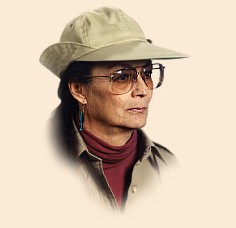|
More of us are getting out on the streams
as the weather warms up and the Spring rains
taper off. We don't always remember everything
we should about how we function in the outdoors,
a little reminder on manners doesn't hurt. There
probably isn't anything chiseled in granite, but
here are a few 'rules.'
Walking lightly, if you've read the suggested 'rules'
above, is very good sense. First you don't want to
destroy any part of our stream - or any of the water
we fish. It just makes sense to do the right thing
to preserve your own fishing, much less to have it
for years to come.
If you live in a region where there are Salmon and
steelhead, you have another very serious reason to
walk lightly - in fact, not to walk at all. Salmon
and steelhead and a lot of other fish use streams
and lakes for spawning and rearing at the same
time people use them for recreational activities.

Salmon and steelhead lay their eggs in spawning nests
called "redds". A redd is a spawning site where the
eggs are buried in the gravel of a stream or a lake
shoreline. For the eggs to survive and develop,
they need clean, loose gravel - usually smaller
than two inches. If silt fills in the spaces
between the gravel, clean water cannot circulate
and the eggs may die from lack of oxygen or from
accumulated waste products.
Even seemingly casual recreational activities may
decrease the spawning success of the very fish we
enjoy. Many recreational activities can cause
impacts that we don't even consider.
When boats, jet boats or jet skis speed across
salmon or steelhead nests they often create
turbulence that may churn up gravel, dispersing
or crushing eggs.
Stirred up sediment can cover redds, causing the
eggs to die from exposure to their own wastes.
When boaters drop and retrieve an anchor in
spawning gravel the anchor can also damage or
destroy redds.
Off-road vehicles, such as mountain bikes, motorcycles,
three-wheelers, quads, and four-wheel drive trucks and
cars are capable of being driven into aquatic zones
where they can impact redds.
When driven through vegetated areas along streams
and lakes ORVs can cause erosion or destroy vegetation
that benefits fish.
When driven through streams ORVs can cause siltation,
gravel compaction, and disruption of eggs. Even
seemingly dry gravel bars may contain redds. Salmon
and steelhead may have spawned in those areas during
high water flows.
It's fun to wade and play in streams. Temporary
dams sometimes are created to provide wading pools
for children. These can block fish trying to get
to spawning areas and the pools can strand young
fish. Walking on spawning beds while wading or
fishing can disrupt incubating eggs, compact gravel,
or stir up silt.
One more thing, don't use streams as travel routes
and don't remove any woody material from stream
channels or gravel bars. The woody debris goes
back into the eco system and provides food for
the growing fish.
Walk lightly - or don't walk at all. It's your
fishing future you are walking on. ~ The LadyFisher
If you would like to comment on this or any other article please feel free to
post your views on the FAOL Bulletin Board!
|



